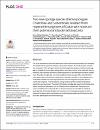Two new sponge species (Demospongiae: Chalinidae and Suberitidae) isolated from hyperarid mangroves of Qatar with notes on their potential antibacterial bioactivity.

View/
Date
2020-05-13Author
Giraldes, Bruno WelterGoodwin, Claire
Al-Fardi, Noora A A
Engmann, Amanda
Leitão, Alexandra
Ahmed, Asma A
Ahmed, Kamelia O
Abdulkader, Hadil A
Al-Korbi, Halah A
Al Easa, Hala Sultan Saif
Ahmed Eltai, Nahla O
Hanifi-Moghaddam, Pejman
...show more authors ...show less authors
Metadata
Show full item recordAbstract
This study presents the taxonomic description of two new sponge species that are intimately associated with the hyperarid mangrove ecosystem of Qatar. The study includes a preliminary evaluation of the sponges' potential bioactivity against pathogens. Chalinula qatari sp. nov. is a fragile thinly encrusting sponge with a vivid maroon colour in life, often with oscular chimneys and commonly recorded on pneumatophores in the intertidal and shallow subtidal zone. Suberites luna sp. nov. is a massive globular-lobate sponge with a greenish-black colour externally and a yellowish orange colour internally, recorded on pneumatophores in the shallow subtidal zone, with large specimens near the seagrass ecosystem that surrounds the mangrove. For both species, a drug extraction protocol and an antibacterial experiment was performed. The extract of Suberites luna sp. nov. was found to be bioactive against recognized pathogens such as Staphylococcus epidermidis, Staphylococcus aureus and Enterococcus faecalis, but no bioactive activity was recorded for Chalinula qatari sp. nov. This study highlights the importance of increasing bioprospecting effort in hyperarid conditions and the importance of combining bioprospecting with taxonomic studies for the identification of novel marine drugs.
Collections
- Biomedical Research Center Research [738 items ]

